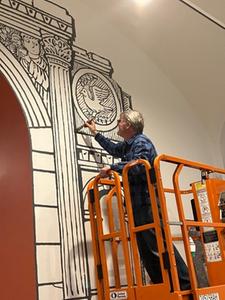An architecturally extraordinary and immersive new exhibition, "Building Stories," curated by children's books scholar Leonard S. Marcus, opened this month at the National Building Museum in Washington, D.C. The exhibit, which is projected to have a 10-year run, was constructed in partnership with the Portland, Ore., exhibition and experiential design studio Plus and Greater Than.
 "Building Stories" features classic and modern literature as well as interactive and original artwork. The exhibit is inspired by the connection between picture books and the worlds--both real and imagined--that humans design and construct around them.
"Building Stories" features classic and modern literature as well as interactive and original artwork. The exhibit is inspired by the connection between picture books and the worlds--both real and imagined--that humans design and construct around them.
The exhibit, spanning four galleries and 4,000 square feet on the museum's ground level, reveals delights at every turn. The first gallery, "Building Readers," welcomes visitors with the sounds of stories. A three-dimensional wall showcasing abecedaries suggests the alphabet as the building block of stories; letters are presented in parallel with concepts of shape and form in construction. Displays focus on architectural models and maps, and include pop-up books and wall didactics that prompt onlookers to consider book-making and design.

|
|
| Leonard Marcus | |
When asked what object in the entire exhibition visitors shouldn't miss, Marcus led visitors to a rare dummy of Margaret Wise Brown and Clement Hurd's Goodnight Moon, the only color version in existence.
To access the second gallery, "Your Home, My Home," one chooses among imposing archways inspired by the building materials of the Three Little Pigs. A round theater dominates this space and alternates multimedia projections of stories in which place plays a character, including Faith Ringgold's Tar Beach and The Snowy Day by Ezra Jack Keats. The room's selections raise thoughtful questions about home--and its loss or absence--in cultures and communities around the world. Visitors feel the global scope of the collection here; the show's 150 books on display represent 28 countries on five continents and span more than 200 years of bookmaking. Young people and adults also pick up exhibition passports in this gallery and can keep the journals as a souvenir.
A particularly effective tapered tunnel beckons next, through a portal that evokes Alice in Wonderland's "Eat Me" moment. Visitors feel as if they're changing size in the passage, then emerge in the third gallery, aptly titled "Scale Play," where perspective and perceptions of the world through children's literature come into focus.
 |
|
| David Macaulay at work on the exhibit. | |
Cathy Frankel, the National Building Museum's deputy director for interpretive content, recalled that legendary artist and author David Macaulay came up repeatedly as she shared the vision to develop an exhibition about books and the built environment. Macaulay was offered an entire room and, Frankel said, "The results are spectacular." Macaulay (Cathedral) hand-painted a Roman archway and provided sketches revealing the creative process behind his 1997 architectural book, Rome Antics. In exposing his complex creative process and daunting "Clouds of Doubt," Macaulay lends a sense of possibility to aspirational amateurs. Maybe writing or illustrating a book is something they can do, too? Additional interactive gallery highlights include magnets to rearrange a house design, audible story snippets piped in via a tube, and a touchable model of the White House.
The final gallery, the lavender-hued "Wider World" inspired by the work of Oliver Jeffers, stands in contrast to the bold, largely black-and-white iconography that precedes this area. Frankel said the museum "worked closely with Jeffers and his studios to create the calming and inspirational space that is part of a call to action for all of us to work together to create a better world." Visitors can construct towers using pillows printed with Jeffers's words and phrases, to forge tiny architectural feats, telling stories that reflect our built world in exploratory and personal ways.
Visitors to Marcus's 2013 exhibition "The ABC of It: Why Children's Books Matter" at the New York Public Library may recognize familiar themes. While multimedia elements and innovative architectural designs here will engross and transport patrons, books remain the core focus. Open shelves in three galleries allow visitors to peruse many books on display and encourage thematic thought beyond the curation. Initially of the mindset that the exhibition would feature "books about building buildings," Marcus invited museum staff to contribute books to those gallery collections. This crowdsourcing led organizers to narrow the focus to how books help us find our place in an engineered world. "We're not just about the physical structures around us," Frankel said. "We're about how those structures affect us, and how we impact them."
The National Building Museum plans extensive programming around the exhibit. Dispelling the myth that picture books are solely for children, the organizers emphasize the exhibit's multi-generational attraction and various access points. "While there's a lot in the show which is designed for children, there's a lot here for everyone," Marcus said. --Kit Ballenger

